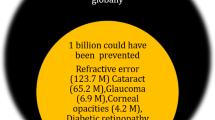Abstract
Artificial Intelligence (AI) has had a major influence on the medical sector. It has the potential to be used for mass screening and may also aid in accurate diagnosis. AI technology is primarily used in optometry and ophthalmology to treat diseases with a high prevalence, such as Retinal Vein Occlusion, Cataract, Age-related Macular Degeneration (AMD), Retinopathy of Prematurity, Diabetic Retinopathy (DR), and Glaucoma. Diabetic Retinopathy is becoming more common among these. It can result in permanent blindness if not diagnosed in a timely manner. As a result, any technologies that can aid in rapid screening, while reducing the need for qualified human resources will likely be beneficial to both patients and ophthalmologists. This paper represents how AI can help with diabetic retinopathy by using Image Recognition technique.
Access this chapter
Tax calculation will be finalised at checkout
Purchases are for personal use only
Similar content being viewed by others
References
Jiang F et al (2017) Artificial intelligence in healthcare: past, present and future. Stroke Vasc Neurol 2(2):230–243
Hopfield JJ (1982) Neural networks and physical systems with emergent collective computational abilities. Proc Natl Acad Sci USA 79(8):2554–2558
Schmidhuber J (2015) Deep learning in neural networks: an overview. Neural Netw 61:85–117
Naveros F et al (2018) Corrigendum: event- and time-driven techniques using parallel CPU-GPU co-processing for spiking neural networks. Front Neuroinform 12:24
Administration UFaD (2013) Guidance for industry: electronic source data in clinical investigations
Darcy AM et al (2016) Machine learning and the profession of medicine. JAMA 315:551–552
Murff HJ et al (2011) Automated identification of postoperative complications within an electronic medical record using natural language processing. JAMA 306:848–855
Murff HJ et al (2011) Automated identification of postoperative complications within an electronic medical record using natural language processing. JAMA 306:848–855
Lee A et al (2017) Machine learning has arrived. Ophthalmology 124:1726–1728
Sajda P (2006) Machine learning for detection and diagnosis of disease. Annu Rev Biomed Eng 8:537–565
Alzubi JA et al (2019) Boosted neural network ensemble classification for lung cancer disease diagnosis. Appl Soft Comput 80:579–591. https://doi.org/10.1016/j.asoc.2019.04.031
Alzubi JA et al (2019) Efficient approaches for prediction of brain tumor using machine learning techniques. Indian J Public Health Res Dev 10(2)
Stoitsis J et al (2006) Computer aided diagnosis based on medical image processing and artificial intelligence methods. Nucl Instrum Methods Phys Res A 569(2):591–595
Vashist P et al (2011) Role of early screening for diabetic retinopathy in patients with diabetes mellitus: an overview. Indian J Community Med 36:247–252
Fong DS et al (2004) Retinopathy in diabetes. Diabetes Care 27(suppl 1):s84–s87
Namperumalswamy P et al (2003) Developing a screening program to detect sight threatening retinopathy in south India. Diabetes Care 26:1831–1835
Bhaskaranand M et al (2016) Automated diabetic retinopathy screening and monitoring using retinal fundus image analysis. J Diabetes Sci Technol 10:254–261
Zheng Y et al (2012) The worldwide epidemic of diabetic retinopathy. Indian J Ophthalmol 60(5):428–431
Author information
Authors and Affiliations
Editor information
Editors and Affiliations
Rights and permissions
Copyright information
© 2022 The Author(s), under exclusive license to Springer Nature Singapore Pte Ltd.
About this paper
Cite this paper
Ajay, Pandey, M. (2022). Artificial Intelligence in Healthcare: Diabetic Retinopathy. In: Gupta, D., Polkowski, Z., Khanna, A., Bhattacharyya, S., Castillo, O. (eds) Proceedings of Data Analytics and Management . Lecture Notes on Data Engineering and Communications Technologies, vol 90. Springer, Singapore. https://doi.org/10.1007/978-981-16-6289-8_39
Download citation
DOI: https://doi.org/10.1007/978-981-16-6289-8_39
Published:
Publisher Name: Springer, Singapore
Print ISBN: 978-981-16-6288-1
Online ISBN: 978-981-16-6289-8
eBook Packages: Intelligent Technologies and RoboticsIntelligent Technologies and Robotics (R0)




